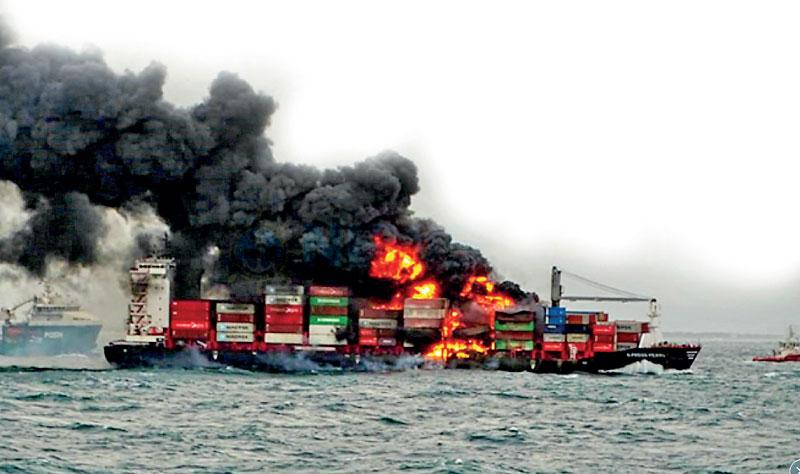Reply To:
Name - Reply Comment
Last Updated : 2024-05-17 11:24:00

MV X-Press Pearl burning off Colombo
Ruwan Samaraweera urges the adoption of the Sendai Framework for Disaster Risk Reduction as it ensures anticipation, preparedness and effective post-disaster relief
 The container vessel MV X-Press Pearl, carrying hazardous chemicals that caught fire and sank off Colombo on May 20, 2021, is still in the news. The Centre for Environmental Justice (CEJ) and the fishermen of Negombo and Chilaw, who had suffered greatly as a result of the massive chemical and plastic pellet spill from the stricken vessel, had filed Fundamental Rights petitions in the Supreme Court seeking compensation.
The container vessel MV X-Press Pearl, carrying hazardous chemicals that caught fire and sank off Colombo on May 20, 2021, is still in the news. The Centre for Environmental Justice (CEJ) and the fishermen of Negombo and Chilaw, who had suffered greatly as a result of the massive chemical and plastic pellet spill from the stricken vessel, had filed Fundamental Rights petitions in the Supreme Court seeking compensation.
The Marine Environment Protection Authority (MEPA) reported an oil slick over 0.51 km2 with a length of 4.3 km around the wreck. According to the International Pollutants Elimination Network, the ship’s cargo included billions of plastic pellets (microplastics used to produce plastic).
Environmental economist Ruwan Samaraweera of the Institute of Policy Studies (IPS) in Colombo says in his blog dated May 3, 2023 that the cargo manifest revealed that at least 81 of the 1,486 containers aboard the MV X-Press Pearl were transporting 15 distinct categories of hazardous materials, including 25 tons of nitric acid. These were washed ashore, causing damage to the country’s marine ecosystem. 300 marine animals, including turtles, dolphins, and whales were killed and over 20,000 fishing families were affected.
Disasters at Global Level
Marine disasters of the X-Press Pearl type are not uncommon. In fact, disasters of high magnitude are a common occurrence in the world. These have given rise to global efforts and systems to meet them and chart out mitigation strategies.
According to the website www.preventionweb.net in 2022, there were 387 recorded disasters, 30,704 deaths, 185 million people were affected and 8.7 million were displaced. The overall loss was US$ 270 billion, including US$ 120 billion in uninsured cases.
The June-September floods in Pakistan affected 33 million people, causing 1,739 deaths and economic damage of US$15 billion. Three major storms in 2022 caused damage worth US$100 billion. Three earthquakes occurred in 2022, with two of these in Afghanistan and Indonesia ranking among the top-ten deadliest disasters.
Small-scale Disasters Equally Damaging
Tens of thousands of small-scale disasters occur each year throughout the world because of flooding, landslides, fires and storms. These events are not reported in international databases. Yet, their impact can be just as damaging as large disasters, causing death, injury and loss of livelihoods.
An analysis of records in 104 countries found that between 2005 and 2017, small and medium, localized and frequent disasters caused 68% of all economic losses,” the site preventionweb.net says. An analysis by the World Bank found that during 1960-2018, climate disasters reduced labour productivity by 7%. And the four epidemics since 2000 (SARS, MERS, Ebola, and Zika) lowered productivity by 4% in three years.
The COVID-19 pandemic led to educational losses. According to UNESCO, nearly 1.6 billion learners in more than 190 countries, and 94% of the world’s student population, were affected by the closure of educational institutions at the peak of the crisis.
Sendai Framework for Disaster Risk Reduction
Sri Lankan environmental economist Ruwan Samaraweera in his blog on the X-Press Pearl disaster says that it revealed institutional and capacity constraints and a lack of training in handling such emergencies in Sri Lanka. He calls for the adoption of the Sendai Framework for Disaster Risk Reduction (SFDRR). He points out that since its inception in 2015, the SFDRR has been widely recognized for managing diverse disasters worldwide.
“Though there are various frameworks and policies related to disaster risk reduction at the national level in Sri Lanka, including the National Disaster Management Plan, they were inadequate to address the X-Press Pearl disaster in a timely and effective way. Other countries use numerous measures like response and containment techniques, preparedness and planning, regulation and enforcement, international cooperation and collaboration,” Samaraweera points out.
“The SDFRR combines these individual efforts and brings them under an umbrella framework. Hence, it offers a comprehensive framework that countries like Sri Lanka can adopt,” he says. Japan has used the SFDRR to tackle climate change, the tsunami, and the Fukushima nuclear disaster. Australia has used it to face wildfires and Nepal earthquakes.
Components of Sendai Framework
According to www.preventionweb.net, the Sendai Framework outlines global targets to be achieved between 2015 and 2030. It aims to prevent and reduce existing disaster risk through the implementation of integrated and inclusive economic, structural, legal, social, health, cultural, educational, environmental, technological, political and institutional measures.
SDFRR’s Goals
The SDFRR’s goals are as follows: By 2030, substantially reduce global disaster mortality to 100,000 ; substantially reduce the number of affected people per 100,000; reduce direct disaster economic loss in relation to global gross domestic product (GDP); substantially reduce disaster damage to critical infrastructure and disruption of basic services, among them health and educational facilities; substantially increase the number of countries with national and local disaster risk reduction strategies; substantially enhance international cooperation through adequate and sustainable support to complement national actions for implementation of this framework; substantially increase the availability of and access to multi-hazard early warning systems and disaster risk information and assessments to people; full engagement of all State institutions of an executive and legislative nature at national and local levels; empower local authorities and communities through resources, incentives and decision-making responsibilities; and address underlying risk factors cost-effectively through investment instead of relying primarily on post-disaster response.
Glaring Lacunae in Sri Lanka
Commenting on the situation in Sri Lanka during the X-Press Pearl disaster, Samaraweera says that it did not have a proper contingency plan in place to deal with a disaster of this scale. Furthermore, the risk assessment conducted prior to granting permission for the vessel to enter Sri Lankan waters did not adequately consider the potential impact of a disaster. Thus, as mentioned in the SFDRR, Sri Lanka should conduct a risk assessment concerning the potential impact of such disasters on the environment, the economy, and public health,” Samaraweera says.
He adds that the first step in preventing disasters like the fire on MV X-Press Pearl is to understand the risks of shipping hazardous materials through Sri Lanka’s waters. The Draft National Transport Policy of 2009 highlights the safer transportation of hazardous material in all modes, but the cabinet has not approved this yet, he points out.
“It is imperative that Sri Lanka reviews its existing laws and regulations, such as the National Environmental Act No. 47 of 1980, the Marine Pollution Prevention Act No. 35 of 2008, and the Dangerous Goods (Transportation) Regulations governing the transportation of hazardous materials and makes necessary amendments to ensure compliance with international standards,” he stresses.
The SFDRR encourages increasing preparedness at all levels of society. But during the X-Press Pearl disaster, emergency responders lacked the necessary equipment and training to respond to the disaster effectively, Samaraweera points out.
“Poor coordination between different agencies hampered the response effort. To address these issues, training programmes in collaboration with the Sri Lanka Navy and MEPA could be conducted for essential stakeholders such as shipping companies, port authorities, and emergency responders,” he suggests.
The SFDRR seeks cooperation and partnership among all parties involved in disaster management. But Sri Lanka did not collaborate effectively with other countries or international organizations to prevent the disaster, Samaraweera complains.
“For example, there was no information sharing about the vessel’s previous safety record, which could have alerted Sri Lanka to potential risks. To avoid similar events in the future, Sri Lanka could collaborate with other nations (India and other South Asian countries), international organizations (such as the International Maritime Organization), and shipping companies,” he says.
The disaster has also brought attention to the need for sustainable shipping practices, such as using alternative fuels and more eco-friendly packing materials, the Lankan environmental economist points out.

Add comment
Comments will be edited (grammar, spelling and slang) and authorized at the discretion of Daily Mirror online. The website also has the right not to publish selected comments.
Reply To:
Name - Reply Comment
The state-run loss-making State Mortgage & Investment Bank (SMIB) has reveale
US authorities are currently reviewing the manifest of every cargo aboard MV
On March 26, a couple arriving from Thailand was arrested with 88 live animal
According to villagers from Naula-Moragolla out of 105 families 80 can afford

23 minute ago
16 May 2024